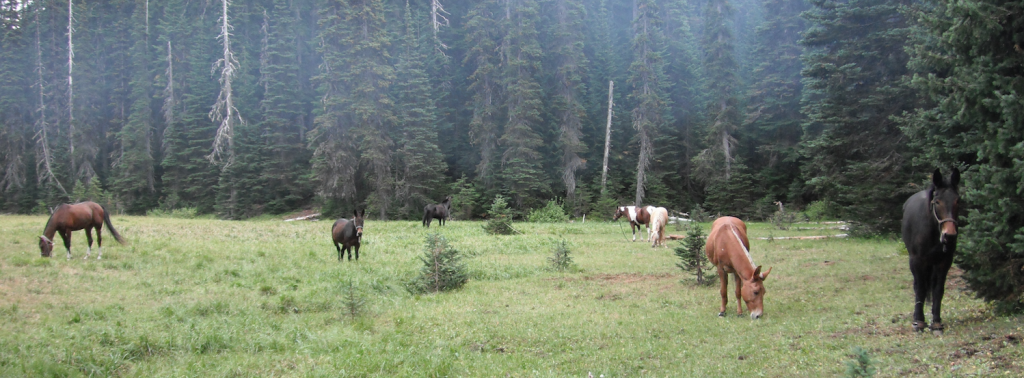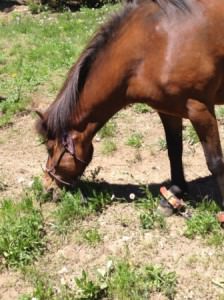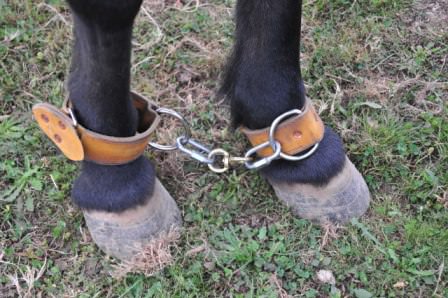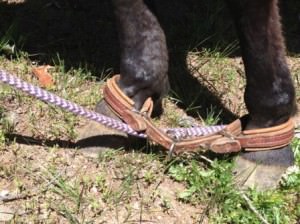 If you use your horses and mules to pack or frequently venture into the back country and beyond the reassuring safety of the trailhead you probably already have a working knowledge of hobbles. Unfortunately many horse and mule owners of today have never seen or used these remarkable versatile tools. Even if we don’t regularly venture into the wilderness hobbles can play a very useful role in our gear box. Indeed, hobbles can be an excellent aid for every rider.
If you use your horses and mules to pack or frequently venture into the back country and beyond the reassuring safety of the trailhead you probably already have a working knowledge of hobbles. Unfortunately many horse and mule owners of today have never seen or used these remarkable versatile tools. Even if we don’t regularly venture into the wilderness hobbles can play a very useful role in our gear box. Indeed, hobbles can be an excellent aid for every rider.
First let’s briefly discuss what hobbles are. Simply put hobbles are devices that limit the locomotion of stock by securing two or more legs. Similar to a pair of handcuffs that are placed around the pastern or cannon bones, hobbles will somewhat limit the range of movement of your animal and help to keep it somewhat near where you left it. On trail rides I’ll often take hobbles to let my horse graze during lunch as opposed to tying him up. If I’m eating and taking a break why not let him grab a bite as well? Hobbles also make backcountry camping without packing in feed much more doable. With a set of hobbles and good grazing your horse can forage for his own breakfast, lunch, and dinner saving you a lot of weight and room in your saddle bags.
Contrary to what some would believe hobbles will not keep a horse or mule or mule from moving. Indeed if they desire, equines can and will move quite quickly and far once they’re used to hobbles. It’s for this reason that you still must  keep an eye on the critters as they graze and be ready to put them up in a more secure manner after their bellies are full and they start to roam.
keep an eye on the critters as they graze and be ready to put them up in a more secure manner after their bellies are full and they start to roam.
Just as horses come in a range of shapes and sizes hobbles also are available in a variety of types and materials. Figure eights, chain, sideline, Mormon, and hard bar are just a few variations of the common two leg hobble and each has its own strengths and weaknesses depending upon your intended use. I’m partial to a buckle-less version hobble which allows your mount to more easily shuffle its front legs while grazing and the buckle-less design eliminates any awkward fumbling with straps and fasteners on cold wet mountain mornings. Two others popular types of hobbles are the “Figure Eight” and “Two Ring” (also known as a Utah) hobble. A benefit of both of these hobbles is the ability to strap them around your mount’s neck, which makes them very easy to get to when it’s time to take a break while riding.
When looking for a set of hobbles look for robust construction and heavy duty materials. Hobbles are one area that I forego my usual mantra of lightweight materials. Early in my explorations of hobbles I tried a nylon set and despite having heavy felt padding my mount paid the price with nasty rub burns on his pasterns from the nylon material. After that bad experience I’ve changed to smooth leather hobbles that don’t rub and are easy to clean.
When I use hobbles I always give the area where I’m turning the animals loose a quick look over to ensure that there aren’t any hazards present before I release the beasts. Obstacles such as holes, fallen trees, boulders and such can be too much for an animal to handle when their movement is hindered by hobbles. I like to think of hobbles as devices for areas where I have verified the footing and safety first.
In addition to helping to slow a mule on his way back to the trailer, while you’re still in the backcountry, hobbles are wonderful Leave No Trace LNT tools. Stock that has a bad pawing habit can make a big mess fast while they’re on a highline. Hobbles take will break them of that habit in short order. I’ve also used hobbles to keep horses from pawing at the trailhead while we’re tacking up for a ride. They’re very versatile tools.
Training a beast for hobbles while not difficult, is well beyond the scope of this piece and we’ll venture into that arena another time.



